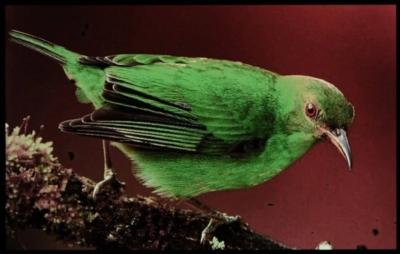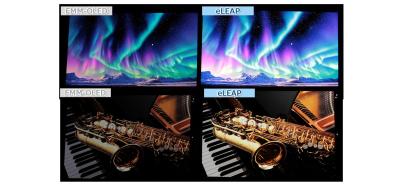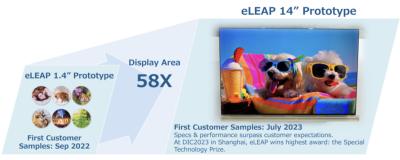Japan Display (JDI) made an interesting announcement today, saying that it has made a strategic investment in OLEDWorks, and now owns 6.69% of the company. The two companies are also planning to build an advanced OLED production line in the US, targeting high-performance displays for the defense, automotive and medical industries.
JDI did not disclose much else, beyond saying that in addition to the manufacturing hub, it will alsop build an advanced display R&D center in the US, together with OLEDWorks. JDI does seem to emphasize OLEDWorks' multi-stack architecture, which maybe means that this technology will be used in the upcoming production line.
OLEDWorks is mostly known for its OLED lighting product line and related technologies, and as a supplier to Audi and others. But the company does develop display technologies as well, although it seems to be mostly focusing on OLED microdisplays. In early 2024, OLEDWorks announced that it has been awarded a $8.6 million US army project to develop high-performance OLED microdisplays. OLEDWorks says that its microdisplay platform is based on OLEDWorks' proprietary multi-stack (3, 4, and 5-stacks) OLED technology for OLED microdisplays.
It could be that JDI also hopes to integrate this multi-stack technology with its own eLEAP maskless production process, which could lead to very efficient, bright and long-lasting AMOLED displays.
In 2022, Japan Display (JDI) announced that it has developed a "historic breakthrough in display technology" - a maskless OLED deposition process which they refer to as eLEAP, that is said to be cost effective and can be used to create freeform OLEDs that are brighter, more efficient, and longer lasting compared to OLEDs produced using mask evaporation (FMM). eLEAP uses Applied Material's MAX OLED deposition system.
JDI is building a small-scale 6-Gen eLEAP production line in Mobara, Japan. The company planned to start production by the end of 2024, but this is now delayed to March 2025.
JDI is also planning to establish a 8.7-Gen eLEAP fab in Wuhu, Anhui Province, China, and hoped to sign an agreement with Wuhu's Economic and Technical Development Zone (WEDZ) by October 2024. This agreement with the WEDZ hasn't been signed, and it's not clear what is the current status of JDI's Wuhu plans.The Wuhu Fab was supposed be a 8.7-Gen line, with a monthly capacity of 30,000 substrates, and it is expected to enter mass production in 2027.
Japan Display was established in 2011 by the merger of Sony's, Toshiba's and Hitachi's display businesses and funded by Japan's government fund Innovation Network Corporation (INCJ). The company was late to realize the importance of OLED production and has struggled financially for many years. It announced a strategic focus on OLED displays in 2017, but never managed to gain major mass production capabilities. The company started to produce OLED displays in 2019, but with low volume. It managed to gain Apple as a customer for Watch wearable displays. This new partnership with HKC could be great news for the company, finally gaining access to the vast amounts of money required to mass produce AMOLEDs.
eLEAP is based on a lithographic method, and does not require any masks. The main advantage seems to be that OLED displays produced by eLEAP technology can achieve an aperture ratio of 60%, compared with FMM OLEDs which achieve a ratio of about 28%. This means that the OLED displays can be driven at lower currents - which extends the lifetime, improves the efficiency and also enables higher-peak brightness when needed.
JDI claims that eLEAP displays offer a boost of 2X in emission efficiency and peak brightness - while lifetime is extended by of 3X (which also reduces burn-in problems). These numbers, if accurate, are highly impressive. JDI is using a 300PPI display for these calculations.
eLEAP stands for environment positive, Lithography with maskless deposition, Extreme long life, low power, and high luminance, and Any shape Patterning. JDI says that eLEAP can be combined with the company's HMO (High Mobility Oxide) backplane technology to dramatically improve OLED display performance. eLEAP production technology can be scaled up to 8-Gen (2200x2500 mm) substrates - or even larger, and is suitable for OLED display production from wearable-size displays to TV sizes.

Finally, JDI says that eLEAP reduces operating costs, reduces material waste and does not require cleaning fluids for the masks - which means that eLEAP significantly reduces material usage, waste and CO2 emissions.
Maskless OLED production technology could provide a dramatic increase in performance in addition to cost reductions - and is an important trend to watch in the industry, as the first maskless OLED displays are to enter the market in early 2025. The OLED Toolbox (updated earlier this month) provides more details and thoughts on maskless OLED production and is a must tool for OLED professionals aiming to stay updated and understand where the OLED industry is heading.




